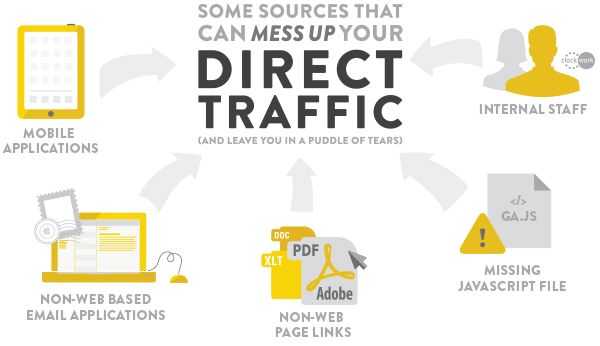Organic Traffic: a brief concept

Online Traffic’ is the most desired things’ in any business. The more you generate traffic to your site, the more is your revenue. Simple!! The First challenge for a business owner is to assure that whenever a user look for something that interests them, whether it’s a product or service they wish to be served, they visit nowhere but your site only. The target here is known as Direct or Organic traffic. We’ve just stepped into this amazing world of internet, we have no desire to spend a single penny to spend before we see a penny earned’ with our own bare eyes. Building a large pool of Organic or real visitor at our site, consider it the hardest effort one ever has to put on the field. We invest our time and effort today to build the quality content today, and this will drive our traffic starting within the next two hours, today or within this year, it will surely return output.
Let’s start the engine, it’s a long way to go….
Table Of Content:
Direct Traffic VS Organic TrafficOrganic Traffic: Understanding the ConceptTraffic Sources · Is this really useful??Best Practice · Killer Tips&TricksTools that Rocks!Be on the Good Side of SEConclusion
Direct Traffic VS Organic Traffic VS Referral Traffic
We have to understand the basic difference of the traffic sources. Those categorized as: 1. Organic/Genuine Traffic, 2. Direct Traffic and lastly, 3. Referral Traffic.
Organic Traffic

Organic traffic this comes from direct searches on SE or Search Engine, or Social Media sites that match the content of your site, the user directs to your page. Leads that come from directly from the SE search is considered as our Organic Traffic. Organic traffic is the most desired things’ for business owners. This traffic is defined as visitors coming from any search engine, such as Google, Bing or Other. One thing to remember, we don’t pay to manipulate these visitors. They hit our page because they’ve prompted a search putting any keyword, or phrase or query that matches the content to our site. Organic traffic is directly connected with SEO. Every Search Engine has their own algorithm and tracking keywords for all the sites, contents there in the web. And again, this algorithm generates some output that results in a Page Ranking method. The better you optimize the contents of your site, keyword density, , put authentic backlinks to it, the more organic traffic will result.
Direct Traffic

Direct traffic is defined as visits without the engagement of any referral or forwarded by other sites through a direct search on our sites url or brand name. Any visitor that manually type the URL for your site or bookmark your site and clicks onto your site, referred as Direct Traffic. In many cases, direct traffic occurs due to the members' login panel where they’ve already signed up.
Referral Traffic

Traffic that avails for other website or being forwarded via some online content. Referral traffic occurs due to visitors landing onto your site from other social sites like FaceBook or Twitter, blogs, posts and simple from that source that intentionally forwards them to visit yours. Traffic derived from mobile apps, games, audio,video, or image content falls under the criteria of referral traffic.
Our focus will be on Organic Traffic, its sources and we’ll also get along with a set of effective and proven ‘Tips&Tricks’. What’s wrong with the remaining Two category?? Nothing. It's just they don’t consolidate to the ground we’re standing right Now. Three strong logic to stick with this statement: Direct Traffic won’t occur if you don’t have Organic traffic. It comes later. A visitor will directly search with your site URL and once only, he/she’s your regular visitor or become a fan of yours. You have to bring him to your site first, and then he/she finds the site beneficial and they turn habituated in visiting your site on a regular interval. Referral traffic is often treated as PAID Traffic. Why would someone drive their visitors to yours!! The only logical reason is, they’re getting paid for doing so. You have to become their ‘Affiliate’ to position your site as the ultimate destination. Organic Traffic is undoubtedly the biggest volume that you can ever reach comparing to that of the remaining categories. Make Sense, ?
Organic Traffic: Understanding the Concept
There are more or less 100+ Search Engines all over the web; most of them remains unknown to the basic web users. We target Google’ as it’s the biggest, greatest and popular search engines for the time being. Like all other search engines, Google has their own analytic keyword features or tools that tracks exactly where a site gets its traffic. Google has their own labeling technique to signify the authenticity of those traffic. A tool known as Google Analytics’ exhibits the for traffic that we refer ‘Organic’ as “unknown” or “SSL” and Direct Traffic as ‘Direct/None.’ Similarly, sites like HubSpot label green’ on the source graph.
Source
We’ve already defined the primary source for Organic Traffic, visitors through SE or SM. , the scope is not that narrow, rather there’s a vast pipeline that brings your potential traffic, which even you’re not aware of. Some other instances that can be included as the source of Organic Traffic’: Other instances can include: · Referral traffic can also be organic, sounds tricky? Visitors can arrive on your site even other sites don’t refer you directly. · Through Newsletter or E-mail template sent in the visitors' email. (Applicable if site owners run an email campaign) · Click link from any PDF Doc or Posts that includes your site URL · Links generated from a SmartPhone App for any Social Media like FaceBook, twitter, Viber or Snapchat. (Mob apps restricts referral tracking) · Visitors can access a shortened URL anywhere in the web and lands onto your site (Google URL shortener features) · Going to a non-secure (http) site from a link on a secure (https) site, as the secure site won’t pass a referrer to the non-secure site.
Is this really useful??
Of course, the larger the volume of your Organic traffic, the more revenue it earns for you. Formerly, we proposed a comparative advantages for Organic traffic than that of Direct or Referral ones. Lets break it up here: · No payment, no traffic (not sustainable). A site that offers referral linking is bound to get paid for this service. Whatever method you choose for your affiliation, Pay-Per-Click, Pay-Per-Imression, Space providing for advertisement or setting up an email campaign with automated Bulk Email provider like MailChimp or any other; once you stop paying them, the flow stops.
· Direct traffic is not suitable for Newly launched site. Most importantly, the site has managed no organic visitor or follower group makes no mean to a neutral user, whom you think will type or search for your site URL manually. You MUST reach at a certain stage, where you’ve managed to build up a large pool of visitors who’re immune to your site contents, get benefitted and turned into a regular visitor. Just the two of these reasons is enough for you to understand why you should focus on Organic Traffic Generation primarily, agree?
Best Practice
“How do I generate this traffic that you’re talking about?” The answer is, SEO. It's all about Search Engine Optization. We’ve talked about it a lot on our previous articles. Check out**** Search Engine Optimization might have three different methods. 1. On-Page SEO, 2. Off-Page SEO and finally On-Site SEO. The best method to start with can be On-site SEO. Making sure that our site content is not only indexable but it shows on top of the SE web crawling bots. It is important that you must take good care of Titles, Tags, URL, Descriptions, broken links etc. CONTENT and High Quality content, whether its blog, image, video or podcasts, even a Q/A session, give it your best man! Whatever business niche you’re in, remember the golden and simplest rule. Write to your Readers, Not Search Engine. Content marketing is the best way to attract organic traffic. The key is to write content based on something what people are seeking for. Though, writing SEO optimized content is not easy as it consist of many steps, which starts from doing Keyword research, writing content based on our Target Keywords and then promoting the content to increase it’s search engine friendly. Link building is a part of SEO strategies. Search engines loves quality links and hate irrelevant links. Thus, it is important to have relevant and quality links to your blog. Links can be backlinks, outbound links, reciprocal links, connect to other blogs directly or indirectly, but the only thing to remember is to get links from good PR and same niche blog. Consistency: Means, writing on a regular interval creates an impression in your visitors that you’re damn serious about providing good content, reaching out to help others and most importantly, you’re the One who’s dedicated to fixing their tools. They start to trust you and in your competency. Increase visit time: Guest blogging: Aim for authoritative websites with high quality content, Go for guest bloggers only within your niche, Value the guest posts and promote them, build a long-term and trustworthy relationship by being consistent in response and quality of Q/A sessions. (Because you want their visitors to eventually become your visitors as well)
TIPS & TRICKS:
· Update and re-publish your previous blog post There are three steps can be followed.
Step #1: Identify those posts managed the most interests into your visitors.
Step #2: Dig them up, put on the surgery table and improve them, if possible rewrite them.
Step #3: Republish your improve blog. Remember, first time visitor reads the oldest content first. Chances are, 90%+ of the people that might benefit from your content never see it. [http://backlinko.com/content-relaunch ] · Focus on long-tail key phrases. The most broadly used keywords or phrases are already optimized and almost captured by giant marketers. We can stand our ground. · Provide them the option to subscribe and follow your site on Social Media sites as FaceBook or Twitter. You should add social bookmarking buttons on your blog that people can easily share your content on their favorite social bookmarking sites. · Offer email-subscription to your blog. Email subscription pop-ups will help them stay connected (because you already have an automated template for newsletter and email notifier.)
SOME TOOLS to use

Google provides two awesome tools for tracking traffic into your sites. These are really handy tools to analyze your traffic trends and reconstruct your strategy for the future.
Google Analytics: tools that matters
Google Analytics is a premium web analytics service offered by Google that tracks and reports website traffic. [https://en.wikipedia.org/wiki/Google_Analytics]
You emphasized the importance of seeing where your traffic was coming from. You went on and on about how Google Analytics can show traffic sources to pinpoint whether people came from search, social media or a specific site referral, Using this information wisely, you can quantify the value of your paid marketing campaigns, optimize Organic traffic, find out how well your newsletter emails are performing and more! Traffic source dimensions Source: Every referral to a web site has an origin, or source. Possible sources include: “google” (the name of a search engine), “facebook.com” (the name of a referring site), “spring_newsletter” (the name of one of your newsletters), and “direct” (users that typed your URL directly into their browser, or who had bookmarked your site). Medium: Every referral to a website also has a medium. Possible medium includes: “organic” (unpaid search), “pec” (cost per click, i.e. paid search), “referral” (referral), “email” (the name of a custom medium you have created), “none” (direct traffic has a medium of “none”). Keyword: When SSL search is employed, Keyword will have the value (not provided). Campaign is the name of the referring AdWords campaign or a custom campaign that you have created. Content identifies a specific link or content item in a custom campaign. For example, if you have two call-to-action links within the same email message, you can use different Content values to differentiate them that you can tell which version is most effective. You can use Custom Campaigns to tag links to use your own custom values for the campaign, Medium, Source, and Keyword.
Google URL Builder tool
Google’s URL Builder tool makes the process of tagging URLs simple. This tools generates campaign variables analysis whch helps you to track the most traffic generating promotions that you're running currently. For example, a unique URL that we use while posting a new Twit' or wall post on Facebook for promoting links.
Be on the Good Side of SEO
Avoid getting penalized by SE like Google or Yahoo. Sounds Interesting, huh? It seems pretty simple to comply with the Search Engine regulations and rules they impose. Here we’re talking about optimizing our sites contents, promoting adds without stepping over the RED LINE. There’re some common techniques and methods misused by the site owners often go for, which can really put their ‘ass on fire.’ To mention some of the methods really needs to be avoided includes:
Word Staffing— Intentionally putting repeated words (keywords) and create exaggerate density to rank higher in Search Engine algorithms. Cloaking— known as indexing. Simply, showing the SE a page by indexing while the actual visitor lands onto a different page. Add black or White text— Marking any word invisible to viewers or we say Search Engines
Conclusion
We can conclude this discussion with this simple statement, that your site will feed on the traffic that comes because your content interests them. Nothing is more valuable than to keep them connected. Yes, you’ve gone through this whole article; you must have set it in your mind that Organic Traffic Generation’ is the result of a long hold hard effort and following a specific procedure consistently, that you have to gain. It's earned, not given. So, do that time to create your own followers, continuously upgrade the site content, stay connected, understand the traffic trends and eventually, it’ll lead you to have the most of your possible traffic generation. Grab every single loophole that your competitors missed, it's your opportunity, and Mostly, try to be in the best zone of Search Engines.
____________________________________________________________________________
for more information follow me:
____________________________________________________________________________